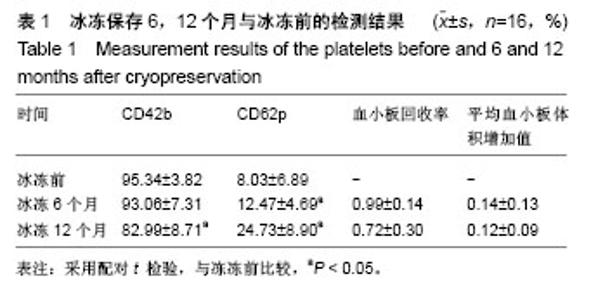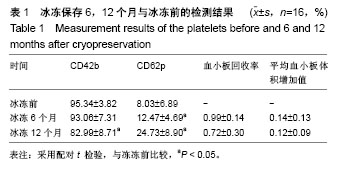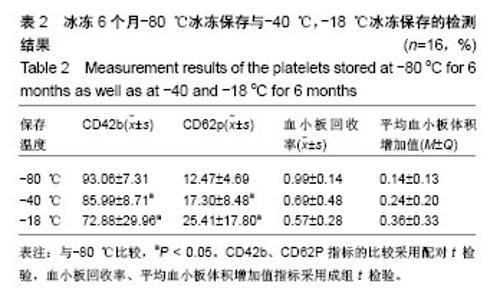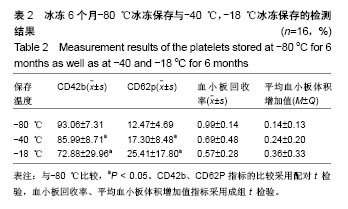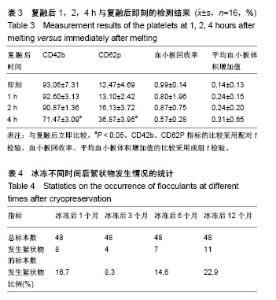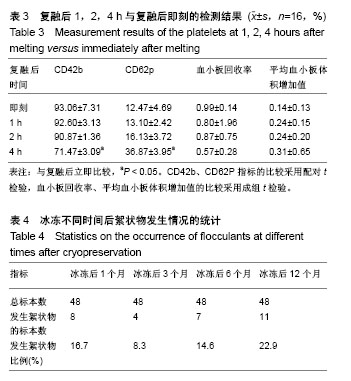| [1] 杨振宇,李正发,付凌梅. 深低温冷冻保存血小板的研究进展[J].临床输血与检验,2016,18(1):82-86.[2] Crowe JH, Tablin F, Wolkers WF, et al. Stabilization of membranes in human platelets freeze-dried with trehalose. Chem Phys Lipids. 2003;122(1-2):41-52.[3] Angelini A, Dragani A, Berardi A, et al. Evaluation of four different methods for platelet freezing. In vitro and in vivo studies.Vox Sang. 1992;62(3):146-151.[4] 杨同华,赵仁彬,沈晓梅,等.冷冻保存自体血小板输注式造血干细胞移植治疗恶性血液病[J].医学研究杂志,2007,36(2):58-60.[5] Wandt H, Schaefer-Eckart K, Frank M, et al. A therapeutic platelet transfusion strategy is safe and feasible in patients after autologous peripheral blood stem cell transplantation. Bone Marrow Transplant. 2006;37(4):387-392.[6] 鲁国勇,李晓燕.机采血小板与冰冻血小板在临床中的应用比较[J].中国现代医药杂志,2013,15(3):88-90.[7] Desai PH, Kurian D, Thirumavalavan N, et al. A randomized clinical trial investigating the relationship between aprotinin and hypercoagulability in off-pump coronary surgery.Anesth Analg. 2009;109(5):1387-1394.[8] Pastore JJ, Funaki M, Janmey PA, et al. Flavonoid-mediated inhibition of actin polymerization in cold-activated platelets. Platelets. 2005;16(6):362-367.[9] 丁国良,秦卫胜,赵林园,等. 冰冻血小板的关键制备技术及临床应用研究[J].中国实验血液学杂志, 2016,24(4):1226-1231.[10] Valeri CR, Ragno G, Khuri S.Freezing human platelets with 6 percent dimethyl sulfoxide with removal of the supernatant solution before freezing and storage at -80 degrees C without postthaw processing.Transfusion. 2005;45(12):1890-1898.[11] 刘利明,李延俊,肖泽斌,等.冰冻机采血小板复融后的质量研究[J].中国民康医学,2009,21(1):27-30.[12] 杨世明,张勇萍,田榆.单采冰冻血小板临床应用疗效的分析[J].第四军医大学学报,2009,30(21):2438-2440.[13] Rahe-Meyer N, Pichlmaier M, Haverich A, et al. Bleeding management with fibrinogen concentrate targeting a high-normal plasma fibrinogen level: a pilot study.Br J Anaesth. 2009;102(6):785-792.[14] 邓为彬,李飞,邓为科,等.冰冻血小板保存的研究进展[J].现代生物医学进展,2008,8(6):1191-1193.[15] Gawaz M, Dickfeld T, Bogner C, et al. Platelet function in septic multiple organ dysfunction syndrome.Intensive Care Med. 1997;23(4):379-385.[16] 刘景汉,欧阳锡林,石群,等.富含血小板血浆制备过程中CD62p表达[J].中国实验血液学杂志,2002,10(3):253-256. [17] 杨丽云,吴承高,刘威,等. 冰冻单采血小板与新鲜单采血小板临床应用效果评价[J].中国输血杂志, 2017,30(7):730-733.[18] Hornsey VS, McMillan L, Morrison A, et al. Freezing of buffy coat-derived, leukoreduced platelet concentrates in 6 percent dimethyl sulfoxide.Transfusion. 2008;48(12):2508-2514.[19] Schoenfeld H, Griffin M, Muhm M, et al. Cryopreservation of platelets at the end of their conventional shelf life leads to severely impaired in vitro function.Cardiovasc J S Afr. 2006; 17(3):125-129.[20] 陈倩,张志亮,屈璐,等. 深低温保存单采血小板凋亡相关miRNA的差异表达[J]. 中国输血杂志, 2017,30(11):1235-1238.[21] 张秀娟.冰冻血小板制品的制备和临床应用[J].科技创新导报, 2013,13:178.[22] 万广增.深低温冻存自体血小板输注治疗恶性血液病化疗后血小板减少症的疗效和安全性[J].中国现代医生, 2017,55(6): 89-90.[23] 刘长利,吕秋霜,任芙蓉,等.冰冻保存血小板的研究[J].中国输血杂志,2003,16(2):128.[24] 曹怡雪,李孝辉. 冰冻血小板融化后出现絮状物原因分析及预防对策[J].临床医药文献杂志, 2017,4(61):11883-11884.[25] 黄彦,梁芬,李小梅. 影响冰冻血小板质量的因素[J].中国现代医药杂志,2007,9(6):71-72.[26] Italiano JE Jr, Bergmeier W, Tiwari S, et al. Mechanisms and implications of platelet discoid shape.Blood. 2003;101(12): 4789-4796.[27] Wolkers WF, Tablin F, Crowe JH.From anhydrobiosis to freeze-drying of eukaryotic cells.Comp Biochem Physiol A Mol Integr Physiol. 2002;131(3):535-543.[28] 余福桥. 细胞低温损伤机理与血小板冰冻保存[J].国外医学:临床生物化学与检验学分册, 2003,24(6):358-360.[29] 邱玉霞.冰冻机采血小板制备、储存、解冻过程中的质量控制[J].现代医学,2010,38(4):397-399.[30] Landi EP, Roveri EG, Ozelo MC, et al. Effects of high platelet concentration in collecting and freezing dry platelets concentrates.Transfus Apher Sci. 2004;30(3):205-212.[31] 杜克清,吴绪华,流景汉,等. 冰冻机采血小板出现析出物的原因分析与对策[J]. 中国输血杂志, 2006,19 (2):134-135.[32] 刘景汉,阳锡林,庄远,等.-80℃长期保存血小板的可行性研究[J].中国输血杂志,2008,21(4):243-245.[33] 于洋,刘景汉. 低温保存血小板基础与应用研究进展[J]. 中国输血杂志, 2003, 16(6): 431-434.[34] 姚勇,蒋红周,张健,等.机采血小板低温冰冻保存与常规液态保存的主要参数比较[J]. 临床输血与检验, 2015,17(6):515-517.[35] Pedrazzoli P, Noris P, Perotti C, et al. Transfusion of platelet concentrates cryopreserved with ThromboSol plus low-dose dimethylsulphoxide in patients with severe thrombocytopenia: a pilot study.Br J Haematol. 2000;108(3):653-659.[36] Rebulla P, Morelati F, Revelli N, et al. Outcomes of an automated procedure for the selection of effective platelets for patients refractory to random donors based on cross-matching locally available platelet products.Br J Haematol. 2004;125(1):83-89. |
